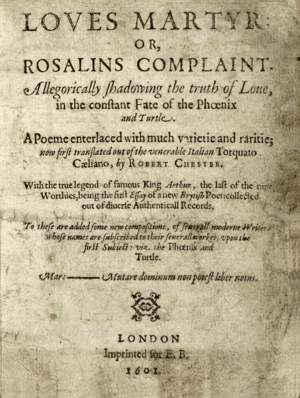John Salusbury (poet) facts for kids
Sir John Salusbury (born 1567 – died 24 July 1612) was a Welsh knight, politician, and poet. He lived during the time of Queen Elizabeth I. He was known for being against a powerful group led by the Earl of Essex. He also supported a special kind of poetry that used hidden meanings and puzzles.
Contents
Life of Sir John Salusbury
Salusbury was part of the important Salusbury family from Lleweni in Denbighshire, Wales. His family owned a large estate, including Lleweni Hall. Many family members gained honors by supporting the Tudor monarchs.
Early Life and Family Challenges
John was born in 1567. His parents were Sir John Salusbury and Katheryn of Berain. His older brother, Thomas Salusbury, was executed in 1586. This happened because Thomas was involved in a secret plan, called the Babington Plot, against Queen Elizabeth I.
After his brother's death, John took over the family lands. However, many of their properties were lost because of the plot. It took him several years to get them back.
Loyalty to the Queen
In 1595, Queen Elizabeth I made John Salusbury a "squire of the body." This meant he was a personal attendant to the Queen. John was very loyal to the Queen. This was different from some other family members who were suspected of supporting the Catholic Church and plotting against her.
John was a strong Protestant. He even wrote to the Queen's minister, Robert Cecil, to report people who refused to follow the official church. He also disagreed with the Earl of Essex. John often had conflicts with Essex's supporters in local politics.
Political Conflicts and Knighthood
In 1593, John almost killed his cousin Owen in a sword fight. Owen supported the Earl of Essex and was already seen as a possible rebel. So, this fight did not harm John's reputation. The 5th Earl of Derby, whose sister Ursula was John's wife, even congratulated him for beating "that bad fellow."
After the Essex Rebellion in 1601, John Salusbury was knighted on June 14, 1601. This was for his help in stopping the rebellion. His cousins Owen and John were involved in the rebellion, and Owen was killed.
These conflicts led to a riot in Wrexham in October 1601. This happened during an election for parliament. John Salusbury's supporters fought with Essex's remaining supporters. John complained to the Queen about being threatened. After a new count, he was declared the winner. He became a Member of Parliament (MP) for Denbighshire in December 1601. However, he only served for a few days before parliament ended.
Later Life and Interests
After Queen Elizabeth died, King James I became the new ruler. Essex's supporters who were still alive gained favor with the new king. After this, John Salusbury spent less time in London. His enemies tried to make him look bad at court.
John became very interested in gardening, plants, and herbal medicine at his home in Lleweni. His copy of Gerard's Herbal (a book about plants) still exists today. It has his notes about plants and herbs he found in Welsh gardens or growing wild around 1606. Some of his notes even include recipes. Sir John Salusbury died on July 24, 1612.
Sir John Salusbury's Family
In 1586, John Salusbury married Ursula Stanley. She was the daughter of Henry Stanley, 4th Earl of Derby. Their first child, Jane, was born on October 6, 1586. John and Ursula had ten children in total. Six of them lived to be adults: four girls and two boys. His son, Henry Salusbury, became the first of the Salusbury Baronets in 1619.
Sir John Salusbury's Literature and Poetry
Sir John Salusbury was a poet himself and also supported other writers. Several books were dedicated to him. In 1595, Henry Perry dedicated his Welsh grammar book, Egluryn Ffraethineb, to Salusbury. Sinetes Passions (1597), a collection of poems by Robert Parry, was also dedicated to him.
The most important book connected to Salusbury is Love's Martyr by Robert Chester. This book was also dedicated to Sir John. Both Parry and Chester were likely writers from Denbighshire who were part of Salusbury's group of friends.
Some people believe that Salusbury's own poems were published in Parry's collection. These poems included a complex symbolic poem for his sister-in-law, Dorothy Halsall. Other poems and love songs by him can be found in old handwritten copies.
Chester was probably Salusbury's chaplain or secretary. Chester's long poem is a very complex story with hidden meanings about a phoenix and a turtledove. Many people have tried to figure out what it means. Some think it's about the love between John and Ursula. Others believe it represents the special relationship between Sir John and Queen Elizabeth.
Chester's poem also has a section called "Cantos" at the end. Some experts, like William Empson, think these "Cantos" were written by Salusbury. They are similar to poems added to Robert Parry's book and show Salusbury's clever and skillful writing. E. A. J. Honigmann suggests that Salusbury loved "mystical verse" with hidden puzzles. This interest might explain the unique, deep symbolism in the poems of Parry, Chester, and Salusbury himself.
Sir John Salusbury also seemed to know Ben Jonson, a famous writer. Jonson might have gathered other important poets to add verses to Chester's poems. These poets included Jonson himself, John Marston, George Chapman, and even William Shakespeare. Shakespeare contributed a famous poem called The Phoenix and the Turtle. These poems share similar images and the complex, hidden meanings found in Love's Martyr and Salusbury's own work.



